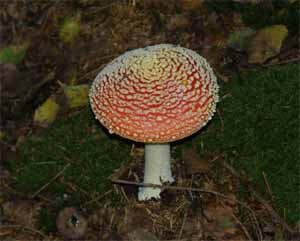- Agaricomycetes
Taxobox
name = Agaricomycetes

image_width = 250px
image_caption = "Amanita muscaria " (Agaricales )
regnum = Fungi
subregnum =Dikarya
phylum =Basidiomycota
subphylum =Agaricomycotina
classis = Agaricomycetes
classis_authority = Dowell, 2001
subdivision_ranks = Subclasses/Orders
subdivision =Agaricomycetidae Phallomycetidae
"incertae sedis " (no subclass)
:Auriculariales
:Boletales
:Cantharellales
:Corticiales
:Gloeophyllales
:Hymenochaetales
:Polyporales
:Russulales
:Sebacinales
:Thelephorales
:Trechisporales The class Agaricomycetes includes not only
mushrooms but also most species placed in the old outdated taxa Gasteromycetes and Homobasidiomycetes. The Agaricomycetes include about 16,000 described species (53% of the described basidiomycetes). Thetaxon is roughly identical to that defined for the Homobasidiomycetes by Hibbett & Thorn [cite book | author = Hibbett, D.S. & R.G. Thorn | editor = McLaughlin, D.J. "et al." (eds) | title = The Mycota, Vol. VII. Part B., Systematics and Evolution | pages = 121-168 | location = Berlin | publisher = Springer-Verlag] ) with the inclusion ofAuriculariales andSebacinales . [cite journal | author=Hibbett, D.S., "et al." | month=Mar | year=2007 | title=A higher level phylogenetic classification of the Fungi| journal=Mycol. Res. | volume=111 | issue=5 | pages=509–547 | doi=10.1016/j.mycres.2007.03.004] Within the subclass Agaricomycotina, which already excludes the smut and rust fungi, the Agaricomycetes can be further defined by the exclusion of the classes Tremellomycetes and Dacrymycetes which are generally considered to be jelly fungi. However, a few former "jelly fungi", such as "Auricularia ", are classified in the Agaricomycetes.Although morphology of the mushroom or fruiting body was the basis of early classification of the Agaricomycetes, [Fries EM. (1874). "Hymenomycetes Europaei". Upsaliae.] this is no longer the case. As an example, the distinction between the "Gasteromycetes" (
puffball s) and "Agaricomycetes" (most other mushrooms) is no longer recognized as a natural one—various puffball species have apparently evolved independently from agaricomycete fungi. However, most mushroom guide books still group the puffballs or gasteroid forms separate from other mushrooms because the older Friesian classification is still convenient for categorizing fruiting body forms. Similarly, modern classifications divide the gasteroid orderLycoperdales betweenAgaricales andPhallales .All members of the class produce
basidiocarp s and these range in size from tiny cups a few millimeters across to giantpolypore s greater than a meter across and weighing up to 130 kg (286 lb). The group also includes what are arguably the largest and oldest individual organisms on earth: themycelium of "Armillaria gallica" have been estimated to extend over 150,000 square metres (37 acres) with a mass of 10,000 kg (22,000 lb) and an age of 1,500 years. [cite journal | author=Smith, M. et al.|year=1992| title= The fungus Armillaria bulbosa is among the largest and oldest living organisms| journal=Nature| volume=356| pages=428–431| doi= 10.1038/356428a0]Nearly all species are terrestrial (a few are aquatic), occurring in a wide range of environments where most function as decayers, especially of wood. However, some species are pathogenic or parasitic, and yet others are symbiotic, these including the important
ectomycorrhizal symbionts of forest trees. General discussions on the forms and life cycles of these fungi are developed in the article onmushroom s, in the treatments of the various orders (links in table at right), and in individual species accounts.References
External links
* [http://tolweb.org/Agaricomycetes/20535 Tree of Life Agaricomycetes by David S. Hibbett]
* [http://www.mycokey.com/AAU/Systematics/SystematicsBasiSvamperiget.html Overview of the Basidiomycota from Aarhus University, Denmark]
* [http://www.mykoweb.com/articles/Homobasidiomycete_clades.html Evolution & Morphology in the Homobasidiomycetes]
Wikimedia Foundation. 2010.
